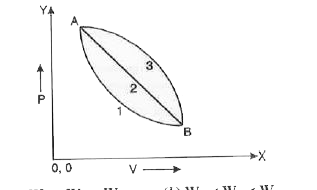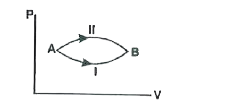Complete Solutions to Multiple Choice Questions (LEVEL-I) of chapter HEAT AND THERMODYNAMICS of Class 12 book with complete answers and questions
| Class 12 | PHYSICS |
| Chapter | HEAT AND THERMODYNAMICS |
| MODERN PUBLICATION | Multiple Choice Questions (LEVEL-I) |
| Number Of Questions | 68 |
| Academic Year | 2023-24 |
`C_(p)-C_(v)=R//J` for one mole of the gas. If we consider n moles of the gas, the formula becomes:
View SolutionThe number of degrees of freedom for molecules of monoatomic gas is
View SolutionThe ratio of slope of adiabatic to that of an isothermal process is:
View SolutionA Carnot's engine operates with a source at 500 K & sink at 375 K. The engine consumes 600 k cal of heat in one cycle, the heat rejected to sink per cycle is:
View SolutionTwo identical samples of a gas expands so that volume is doubled. The first sample undergoes isothermal expansion while the second is expanded adiabatically. The final pressure:
View SolutionA reversible Carnot's engine is working between 260 K and 300K. It takes 500 cal of heat from sink. Heat rejected to the source at higher temp. for this refrigerator is:
View SolutionOne mole of an ideal gas undergoes cyclic change as shown. The work done in the process is (taking 1 atmosphere `=10^(5)" N/"m^(2))`:

View SolutionSpecific heat at constant pressure `C_(p)` for a diatomic gas at N.T.P. in the units of cal mole k is:
View SolutionLet a small block of ice of `0^(@)C` fall from a certain height into a water k. It at `0^(@)C`, we find that `(1)/(8)` th of molts when it reaches the ground. The height of the fall is:
View SolutionThe amount of heat required to convert 1 gnm of ice at- `10^(@)C` to steam at `100^(@)C` is:
View SolutionA moving snowball is completely melted by its impact against a wall. The speed (in `ms^(-1)`) of snow ball is:
View SolutionThe velocity with which a ball of ice be thrown against a wall so that it melts completely is:
View SolutionA moving snowball is completely melted by its impact against a wall. The speed (in `ms^(-1)`) of snow bal is:
View SolutionFrom what height a piece of ice at zero degree fall in order that it may melt on reaching the ground, assumin8 no loss of energY on the way :
`(J=4 cdot 2J// cal)`:
View SolutionA bullet moving with velocity `upsilon` stops suddenly after hitting the target and whole of its mass m melts. If s is the specific heat, L the latent heat and its initial temp. is `25^(@)C` and melting point. is `475^(@)C`, then the velocity `upsilon` is given by:
View SolutionTwo identical samples of a gas are allowed to expand:
(i) isothermally and
(ii) adiabatically, the amount of work done is :
View SolutionThe nomal temp. of human body is `98 cdot 6^(@) F`. What is the corresponding temp. of human body in
Celsius scale:
View SolutionA gas at N.T.P. is suddenly compressed to one fourth of its original volume. If `gamma` is supposed to be 3/2 then final pressure is :
View SolutionA bar made of iron for which `alpha =11xx10^(-6)""^(@)C^(-1)` is 10.000 cm at `20^(@)C`. At `19^(@)C` the length is :
View SolutionThe temp. at which centigrade and fahrenheit scales have same reading is:
View SolutionCooking food in a pressure cooker saves time and fuel because:
View SolutionNitrogen is a diatomic gas. Its molar specific heat a constant volume is very nearly:
View SolutionAt what temperature will oxygen molecules have the same root mean square speed as hydrogen molecules at 300 K ?
View SolutionDuring an adiabatic compression of 2 moles of a gas, 100 of work was done. The change in the internal energy will be:
View SolutionIn a thermodynamic process, a system absorbs 2 kilo calorie of heat and at the same time does 500 J of work. What is the change in internal energy of the system:
View SolutionSteam at `100^(@)C` is passed into `1 cdot 1` kg of water contained in a calorimeter of water equivalent `0 cdot 02 kg "at "15^(@)C` till the temperature of the calorimeter rises to `80^(@)C`. The mass of steam condensed in kilogranm is:
View SolutionA metal ball immersed in alcohol weights `W_(1)" at "0^(@)C and W_(2)" at "59^(@)C`. The coefficient of cubic expansion of metal is less than that of alcohol. If the density of the mnetal is large compared to that of alcohol then:
View SolutionTwo cylinders A and B fitted with pistons contain equal amounts of an ideal diatomic gas at 300 K. The piston of A is free to move, while that of B is held fixed. The same amount of heat is given to the gas in each cylinder. If the rise in temperature of the gas in A is 30 K, then the rise in temperature of the gas in B is :
View SolutionAt room temperature `(27^(@)C)` the r.m.s speed of the molecules of a certain diatomic gas is found to be `1920 ms^(-1)`. The gas is:
View SolutionThe average energy of molecules in a sample of oxygen gas at 300K are `6.2 J xx 10^(-21)` J. The corresponding values at 600K are
View SolutionIn a given process on an ideal gas dW = 0 and `dQ angle 0.` Then for the gas :
View SolutionFor a given mass of a gas in an adiabatic change the temperature and pressure are related according to the law:
View SolutionFor increasing the efficiency of Carnot's engine, which of the folowing is most effective:
View SolutionWhen an ideal diatomic gas is heated t constant pressure, the fraction of the heat energy supplied which increases the internal energy of the gas is :
View SolutionThe temperature of Helium gas is raised by `10^(@)C` at constant volume. Heat supplied to gas may be taken partly as translational and partly as rotational kinetic energies. Their respective shares are :
View SolutionThe pressure and density of gas `(gamma =(7)/(5))` changes adiabatically from `(P, rho)" to "(P',rho').` If `(rho')/(rho)=32`, then find the ratio of `(P')/(P)` :
View SolutionThe number of dead centres per cycle for a steam engine is :
View SolutionA faulty thermometer has its fixed points marked `5^(@)C and 95^(@)C`. The thermometer reads the temperature of body as `59^(@)C`. The correct temperature on Celsius scale is:
View SolutionAn ideal heat engine is working between temperature `T_(1) and T_(2)` has efficiency `eta`. If both the temperatures are raised by `100^(@)k` each, the new efficiency will be :
View SolutionThe molar specific heat of oxygen at constant pressure, `C_(p)7.03" cal/mol"^(@)C and R=8.31" Joules/mol"^(@)C`. The amount of heat taken by 5 moles of oxygen when heated at constant volume from `10^(@)C" to "20^(@)C` will be approximately:
View SolutionEqual volumes of copper and mercury have the same thermal capacity. Sp. heat of mercury is `0.046" cal/gm/"^(@)C` and density is 13.6 g/c.c. What is the density of copper if its specific heat is 0.090 ?
View SolutionThe densities of two substances are 2 3 and their specific heats are 0.12 and 0.09 respectively. What is the ratio of their thermal capacities per unit volume ?
View Solution70 calories of heat are required to raise the temperature of 2 moles of an ideal gas at constant pressure from `30^(@)` to `35^(@)`. The amount of heat required in calories to raise the temperature of the same gas through the same range `(30^(@)C" to "35^(@)C)` at constant volume is :
View SolutionBoiling water is changing into steam, under this condition the specific heat of water in `"cals/g/"^(@)C` is:
View SolutionWhat amount of heat must be supplied to `2.0xx10^(-2)kg` of `N_(2)` (at room temperature) to raise its temperature by `45^(@)C` at constant pressure? Molecular mass of `N_(2)=28,R=8.3J"mole"^(-1)K^(-1)`
View SolutionTotal heat required to convert 50 kg of water at `10^(@)C` to steam at `100^(@)C (L.H =2.25 xx 10^(6)" J kg"^(-1))`:
View SolutionFor a certain gas the ratio of specific heat is 1.5, for thisg gas :
View Solution22g of `CO_(2)" at "27^(@)C` is mixed with `16g" of "O_(2)" at "37^(@)C`. The temperature of mixture is:
View SolutionFor an adiabatic change the value of `(dP)/(P)` is equal to `(dV=" change in vol.," gamma =(C_(p))/(C_(v)))`:
View SolutionA system changes from the state `(P_(1),V_(1))" to "(P_(2), V_(2))` as shown, work done by the system is:

View SolutionA metal ring of mass 2.1 kg and of 10 cm radius is revolving about its axis `(350)/(11)` r.p.s. If this ring is dropped in a viscous liquid, then the heat generated is `(J=4.2" J/cal")` :
View SolutionA 50g lead bullet (sp. heat = 0.02) is at `30^(@)C`. It is fired vertically upwards with a speed of `840 m s^(-1)`. On returning to the starting level it strikes the ice cake at `0^(@)C`. How much ice is melted ? (L.H. of ice 80 cal/gm):
View SolutionA given mass of a gas expands from the state A to the state B by three paths 1,2 and 3 as shown in the figure. If `W_(1), W_(2) and W_(3)` respectively be the work done by the gas along the three paths then

View SolutionEfficiency of engine is `eta_(1)" at T_(1)= 200^(@)C` and `eta_(2)" at "T_(1)=0^(@)C and T_(2)=-200 K.` Find the ratio of `(eta_(1))/(eta_(2))` :
View SolutionWhich of the folowing is not a state function ?
View SolutionIn an adiabatic change, the pressue and temperature of a monoatomic gas are related as `P prop T^(c)`, where c equals:
View SolutionThe efficiency of a Carnot engine is 50% and temperature of sink is 500 K. If temperature of source is kept constant and its efficiency raised to 60%, then the required temp. of sink will be:
View SolutionIf AB is an isothermal, BC is an isochoric and AC is an adiabatic, which of the graph correctly represents them in Fig. ?
View SolutionWhich of the following PV diagrams best represents an isothermal process:

View SolutionThe volume of a metal sphere increases by `0 cdot 24%` when its temperature is raised by `40^(@)C`. The coefficient of linear expansion of the metal is…`""^(@)C^(-1)`:
View SolutionWhich statement is incorrect ?
View SolutionEven Carnot engine cannot give 100% efficiency because we cannot :
View SolutionHeat given to a body which raises its temperature by `1^(@)C` is
View SolutionWhich of the following is incorrect regarding the first law of thermodynamics ?
View SolutionA system goes from A to B via two processes I and II as shown in Fig. If `Delta U_(1) and Delta U_(2)` are the changes in internal energies in the processes I and II respectively, then :

View SolutionThe initial state of certain gas is `(P_(i)V_(i)T_(i))`. It undergoes expansion till its volume becomes `V_(f)` at constant temperture T, the corect plot of P-V diagram for it is :
View SolutionAn ideal gas confined to an insulated chamber is allowed to enter into an evacuated insulated chamber. If `Q.W and Delta E_(int)` have the usual meanings, then
View SolutionThe internal energy of one gram of helium at 100 K and one atmospheric pressure is:
View Solution
Multiple Choice Questions (LEVEL-I) questions and complete solutions for chapter HEAT AND THERMODYNAMICS of MODERN PUBLICATION PHYSICS (KANNADA ENGLISH) of Class 12